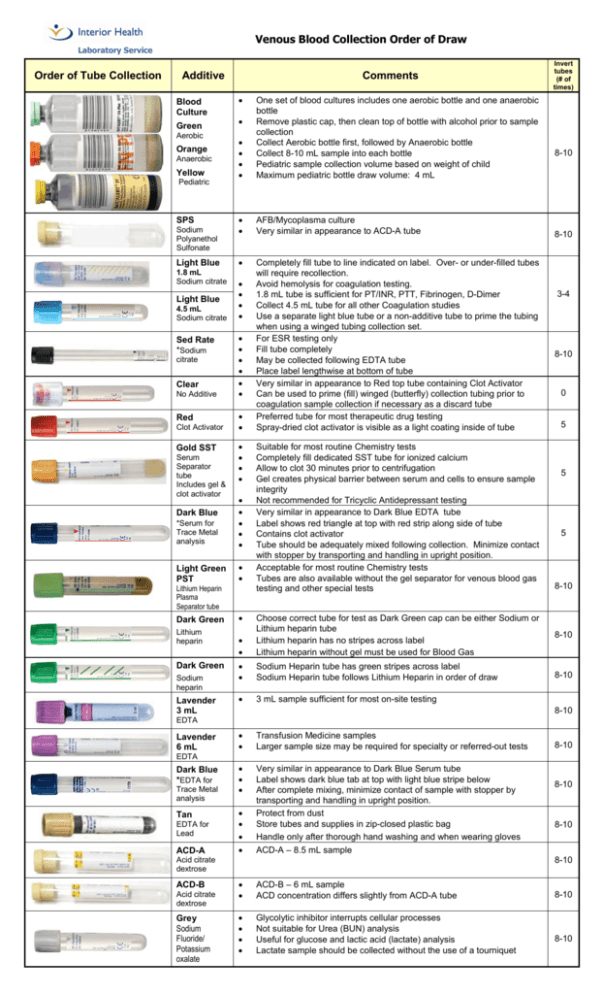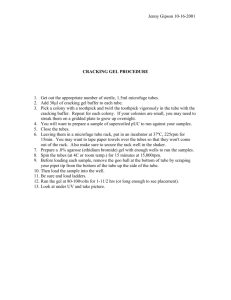Venous Blood Collection Order of Draw Procedure
advertisement

Venous Blood Collection Order of Draw Laboratory Service Order of Tube Collection Additive Blood Culture Green Aerobic Orange Anaerobic Yellow Pediatric SPS Sodium Polyanethol Sulfonate Light Blue 1.8 mL Sodium citrate Light Blue 4.5 mL Sodium citrate Sed Rate *Sodium citrate Clear No Additive Red Clot Activator Gold SST Serum Separator tube Includes gel & clot activator Dark Blue *Serum for Trace Metal analysis Comments • • • • • One set of blood cultures includes one aerobic bottle and one anaerobic bottle Remove plastic cap, then clean top of bottle with alcohol prior to sample collection Collect Aerobic bottle first, followed by Anaerobic bottle Collect 8-10 mL sample into each bottle Pediatric sample collection volume based on weight of child Maximum pediatric bottle draw volume: 4 mL • • AFB/Mycoplasma culture Very similar in appearance to ACD-A tube • Completely fill tube to line indicated on label. Over- or under-filled tubes will require recollection. Avoid hemolysis for coagulation testing. 1.8 mL tube is sufficient for PT/INR, PTT, Fibrinogen, D-Dimer Collect 4.5 mL tube for all other Coagulation studies Use a separate light blue tube or a non-additive tube to prime the tubing when using a winged tubing collection set. For ESR testing only Fill tube completely May be collected following EDTA tube Place label lengthwise at bottom of tube Very similar in appearance to Red top tube containing Clot Activator Can be used to prime (fill) winged (butterfly) collection tubing prior to coagulation sample collection if necessary as a discard tube Preferred tube for most therapeutic drug testing Spray-dried clot activator is visible as a light coating inside of tube • • • • • • • • • • • • • • • • • • • • • • Light Green PST • • Dark Green • Lithium Heparin Plasma Separator tube Lithium heparin Dark Green Sodium heparin Lavender 3 mL Suitable for most routine Chemistry tests Completely fill dedicated SST tube for ionized calcium Allow to clot 30 minutes prior to centrifugation Gel creates physical barrier between serum and cells to ensure sample integrity Not recommended for Tricyclic Antidepressant testing Very similar in appearance to Dark Blue EDTA tube Label shows red triangle at top with red strip along side of tube Contains clot activator Tube should be adequately mixed following collection. Minimize contact with stopper by transporting and handling in upright position. Acceptable for most routine Chemistry tests Tubes are also available without the gel separator for venous blood gas testing and other special tests Invert tubes (# of times) 8-10 8-10 3-4 8-10 0 5 5 5 8-10 • • Choose correct tube for test as Dark Green cap can be either Sodium or Lithium heparin tube Lithium heparin has no stripes across label Lithium heparin without gel must be used for Blood Gas 8-10 • • Sodium Heparin tube has green stripes across label Sodium Heparin tube follows Lithium Heparin in order of draw 8-10 • 3 mL sample sufficient for most on-site testing 8-10 EDTA Lavender 6 mL • • Transfusion Medicine samples Larger sample size may be required for specialty or referred-out tests • • • Very similar in appearance to Dark Blue Serum tube Label shows dark blue tab at top with light blue stripe below After complete mixing, minimize contact of sample with stopper by transporting and handling in upright position. Protect from dust Store tubes and supplies in zip-closed plastic bag Handle only after thorough hand washing and when wearing gloves ACD-A – 8.5 mL sample 8-10 EDTA Dark Blue *EDTA for Trace Metal analysis Tan EDTA for Lead ACD-A • • • • Acid citrate dextrose Grey Sodium Fluoride/ Potassium oxalate 8-10 8-10 Acid citrate dextrose ACD-B 8-10 • • ACD-B – 6 mL sample ACD concentration differs slightly from ACD-A tube • • • • Glycolytic inhibitor interrupts cellular processes Not suitable for Urea (BUN) analysis Useful for glucose and lactic acid (lactate) analysis Lactate sample should be collected without the use of a tourniquet 8-10 8-10 Order of Draw Guidelines: Tubes must be collected in the order indicated according to the tube additive in order to prevent contamination or interference from a preceding tube to a following tube. Culture tubes Sodium citrate No additive Clot activator Lithium heparin Sodium heparin EDTA Specialty tubes* – all types Glycolytic inhibitor *Specialty tubes containing the same additive as listed may be collected according to the additive, as shown for the trace metal and Sed rate (ESR) tubes. Collection Requirements: Strict adherence to the follow ing requirements w ill help to ensure the accuracy and reliability of the patient test result. Identify your patient: Check that your inpatient is wearing a hospital identification band. Ask the patient to state his full name and date of birth. Verify that the patient information matches the requisition and/or labels and the hospital ID band (inpatients). Verify additional primary identifier: For Inpatients: Medical Record Number on facility identification band matches labels/requisition For Outpatients: Other government–issued ID matches information on labels/requisitions i.e. Personal Health Number on Care Card matches labels and requisition Fix any discrepancies before collecting a lab sample. Place a Transfusion Medicine Service (TMS) ID band on the patient’s arm after the patient has been properly identified when collecting a sample for possible transfusion. Prepare for the collection: Select the appropriate tubes for the tests ordered. Check the tube expiration dates. Use only in-date collection tubes. Collect the blood sample: Vascular access device (VAD): Prepare VAD line for blood sample collection according to Clinical Practice (CPM) protocol. Discard appropriate amount of blood when collecting from an indwelling line (VAD): two times the dead space volume for non-coagulation testing 5 mL or six times the dead space volume for coagulation tests Do not discard blood when querying Central Line Associated Blood Stream Infection (CLABSI). First blood removed from line should go into blood culture bottles. Do not collect: coagulation samples through power-PICC line samples for diagnostic testing through lines that are also used to infuse medications or therapies: • Therapeutic drugs for therapeutic drug monitoring tests • Heparin or other anti-coagulant for coagulation testing • Parenteral Nutrition for chemistry analytes Follow CPM protocol for maintaining the patient lines (VAD collections only) when collection is complete. Venipuncture: Follow the steps in the Collecting a Blood Sample by Venipuncture procedure. Fill tubes in the correct order as indicated on the Order of Draw chart. When using a syringe for collection: transfer blood to Vacutainer® tube(s) using a tube holder that allows syringe attachment allow tubes to fill without placing additional pressure on the syringe plunger Never transfer sample from one sample tube to another. Mix samples immediately following collection. One mix is 180° tube inversion, allowing bubble to travel the length of the tube, followed by return to upright position. Label the tubes at the time of collection in the presence of the patient with the following information: Patient last name, first name Patient date of birth Secondary identifier: Medical Record Number (MRN or Unit number) or Personal Health Number (PHN) TMS ID number (as read from the identification band) for Transfusion Medicine Service sample Collector mnemonic Date of collection Time of collection Label each tube individually. Do not wrap a single label around multiple tubes. Do not pre-label tubes with patient information prior to blood collection Deliver tubes to lab: Assess samples for acceptability (lab staff): Inadequate sample volume (includes under- and over-filled coagulation tubes) Presence of hemolysis or other interferent Wrong collection tube Wrong collection time (ie. therapeutic drug monitoring) Inadequate or improper tube labelling Prolonged delay in delivery to lab Other individual criteria related to the test requested Recollect samples not meeting acceptance criteria. Refer to: IH Lab Collecting a Venous Blood Sample Procedure BacT/Alert® blood culture bottles are products of ©BioMerieux, Inc. www.biomerieux-usa.com. Images used by permission. Vacutainer® tubes are products of ©Becton, Dickinson and Company. www.bd.com. Images used by permission. Updated: November 12, 2014




